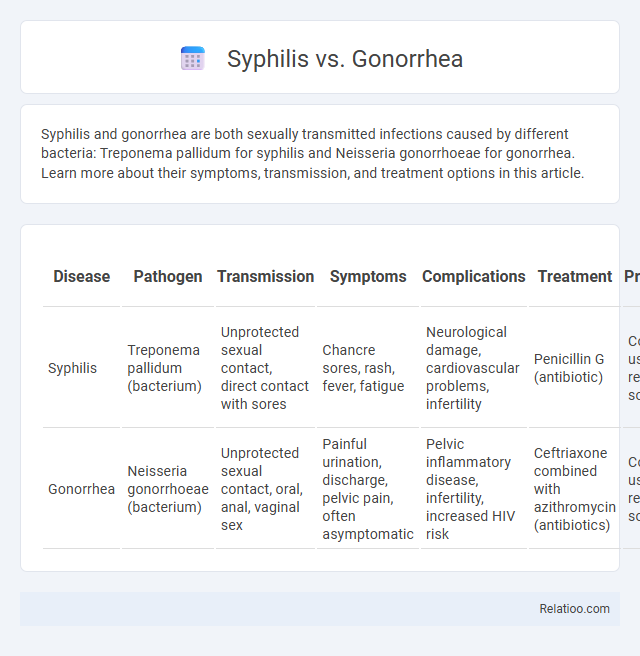Syphilis and gonorrhea are both sexually transmitted infections caused by different bacteria: Treponema pallidum for syphilis and Neisseria gonorrhoeae for gonorrhea. Learn more about their symptoms, transmission, and treatment options in this article.
Table of Comparison
| Disease | Pathogen | Transmission | Symptoms | Complications | Treatment | Prevention | Sexual Compatibility Impact |
|---|---|---|---|---|---|---|---|
| Syphilis | Treponema pallidum (bacterium) | Unprotected sexual contact, direct contact with sores | Chancre sores, rash, fever, fatigue | Neurological damage, cardiovascular problems, infertility | Penicillin G (antibiotic) | Condom use, regular STI screening | Can cause long-term reproductive and sexual health issues if untreated |
| Gonorrhea | Neisseria gonorrhoeae (bacterium) | Unprotected sexual contact, oral, anal, vaginal sex | Painful urination, discharge, pelvic pain, often asymptomatic | Pelvic inflammatory disease, infertility, increased HIV risk | Ceftriaxone combined with azithromycin (antibiotics) | Condom use, regular STI screening | May reduce fertility and cause long-term pelvic pain |
Introduction to Syphilis and Gonorrhea
Syphilis and gonorrhea are two common sexually transmitted infections (STIs) caused by distinct bacteria: Treponema pallidum and Neisseria gonorrhoeae, respectively. Syphilis typically progresses through stages characterized by sores, rashes, and potential organ damage if untreated, while gonorrhea primarily causes urogenital infections with symptoms such as painful urination and discharge. Early diagnosis and antibiotic treatment are crucial for managing both infections and preventing serious health complications.
Overview of Each Infection
Syphilis, caused by the bacterium Treponema pallidum, presents in stages with symptoms ranging from painless sores to neurological complications if untreated. Gonorrhea, resulting from Neisseria gonorrhoeae infection, typically affects mucous membranes causing painful urination and discharge but may become systemic. Sexually transmitted infections (STIs) encompass a broad category including syphilis, gonorrhea, chlamydia, and others, each with unique pathogens, symptoms, and treatment protocols that you should understand for effective prevention and care.
Causes and Modes of Transmission
Syphilis is caused by the bacterium Treponema pallidum, while gonorrhea is caused by Neisseria gonorrhoeae, both transmitted primarily through sexual contact involving mucous membranes. Sexually transmitted infections (STIs) encompass a broad range of pathogens including bacteria, viruses, and parasites, transmitted mainly through vaginal, anal, or oral sex. Vertical transmission from mother to child during childbirth can also occur with syphilis and some other STIs, emphasizing the importance of early detection and treatment.
Key Symptoms and Early Warning Signs
Syphilis often presents with painless sores called chancres at the infection site, typically appearing within three weeks of exposure, accompanied by a rash on the palms and soles during secondary stages. Gonorrhea symptoms include painful urination, abnormal discharge from the genitals, and swollen testicles in men, while many women remain asymptomatic or experience mild pelvic pain. Early warning signs for sexually transmitted infections (STIs) broadly include unusual genital itching, sores, or blisters, pain during intercourse, and unusual vaginal or penile discharge, which necessitate prompt medical evaluation to prevent severe complications.
Stages and Progression of Each Disease
Syphilis progresses through primary, secondary, latent, and tertiary stages, each with distinct symptoms such as painless ulcers in the primary stage and systemic complications in the tertiary stage. Gonorrhea often presents with urethritis or cervicitis early but can progress to disseminated gonococcal infection if untreated, causing arthritis or dermatitis. Sexually transmitted infections broadly vary, but their stages typically include an incubation period, symptomatic or asymptomatic phases, and potential chronic complications if left untreated.
Diagnosis Methods and Testing Procedures
Syphilis is diagnosed through blood tests such as the Rapid Plasma Reagin (RPR) and Treponema pallidum particle agglutination assay (TPPA), while gonorrhea typically requires nucleic acid amplification tests (NAATs) on urine samples or swabs from the infected site. Sexually transmitted infection (STI) testing procedures vary depending on the suspected condition but often include physical examination, laboratory tests, and cultures to identify pathogens. For accurate diagnosis and effective treatment, Your healthcare provider will select testing methods based on symptoms and sexual history.
Treatment Options and Effectiveness
Syphilis treatment primarily involves a single intramuscular injection of benzathine penicillin G, which is highly effective in early stages but requires additional doses for late or latent syphilis. Gonorrhea treatment typically includes a dual therapy of ceftriaxone and azithromycin to combat antibiotic resistance and ensure eradication. Your choice of treatment for sexually transmitted infections should consider timely diagnosis and adherence to prescribed antibiotics to maximize effectiveness and prevent complications.
Potential Complications and Health Risks
Syphilis can lead to severe complications such as neurological damage, cardiovascular problems, and organ failure if untreated, while gonorrhea increases the risk of pelvic inflammatory disease, infertility, and disseminated gonococcal infection. Both infections significantly elevate the likelihood of acquiring or transmitting HIV due to mucosal inflammation and ulcerations. Early diagnosis and treatment are critical to prevent long-term health risks associated with these sexually transmitted infections (STIs).
Prevention Strategies and Safe Practices
Effective prevention strategies for syphilis, gonorrhea, and other sexually transmitted infections (STIs) include consistent and correct use of condoms, regular screening, and reducing the number of sexual partners. Vaccination is available for some STIs, such as HPV and hepatitis B, but not for syphilis or gonorrhea, making early detection and treatment essential. You can protect your sexual health by practicing safe sex, communicating openly with partners, and seeking prompt medical consultation if exposure or symptoms occur.
Comparing Syphilis and Gonorrhea: Key Differences
Syphilis and gonorrhea are both common sexually transmitted infections caused by different bacteria--Treponema pallidum for syphilis and Neisseria gonorrhoeae for gonorrhea--resulting in distinct symptoms and treatment protocols. Syphilis often progresses in stages, presenting with painless sores and systemic complications if untreated, whereas gonorrhea typically causes painful urination and discharge but can also lead to severe reproductive issues. Understanding these differences is crucial for your proper diagnosis, treatment, and prevention strategy.

Infographic: Syphilis vs Gonorrhea
 relatioo.com
relatioo.com